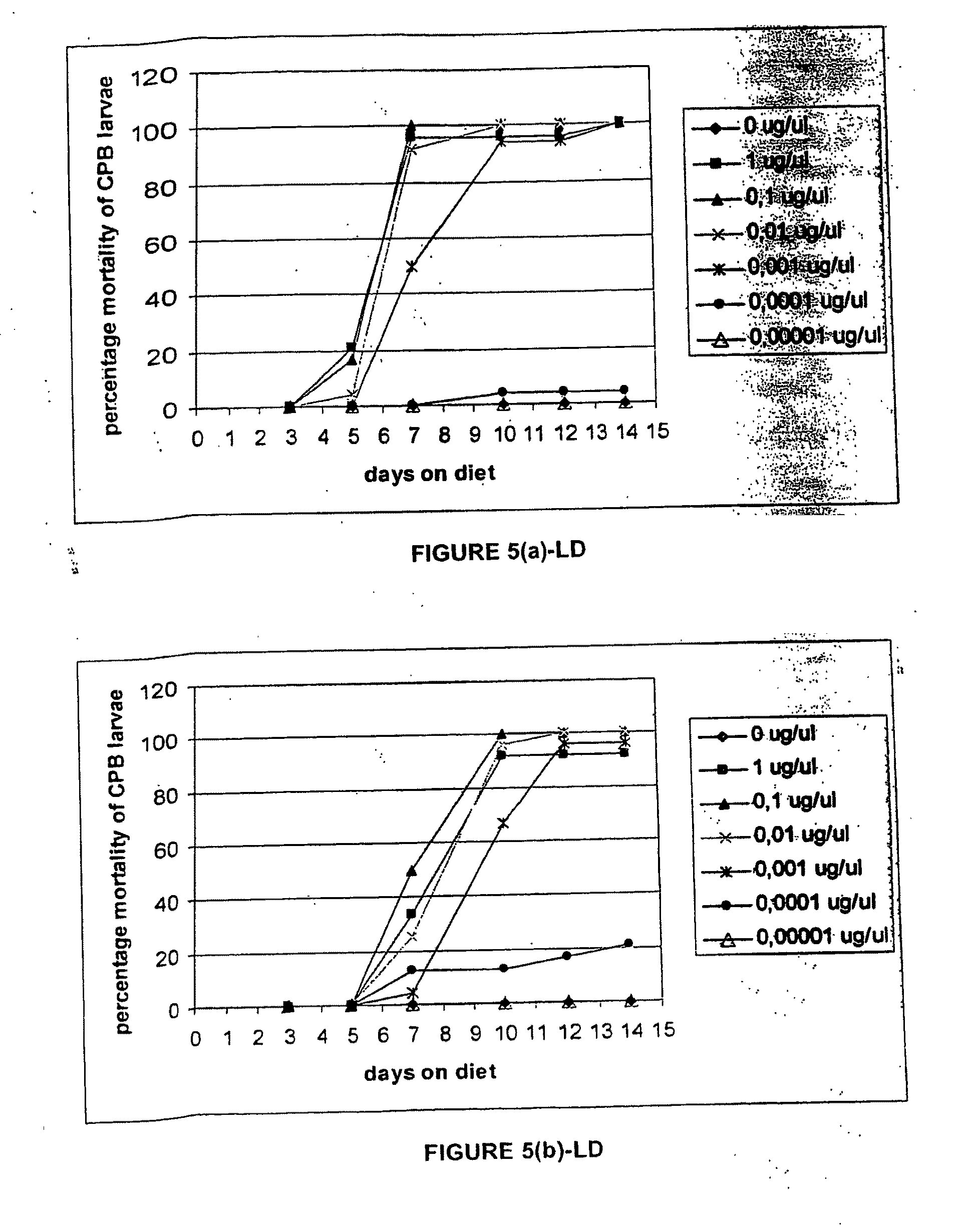Methods for Controlling Pests Using Rnai
- Summary
- Abstract
- Description
- Claims
- Application Information
AI Technical Summary
Benefits of technology
Problems solved by technology
Method used
Image
Examples
example 1
Silencing C. elegans Target Genes in C. elegans in High Throughput Screening
[0219]A C. elegans genome wide library was prepared in the pGN9A vector (WO 01 / 88121) between two identical T7-promoters and terminators, driving its expression in the sense and antisense direction upon expression of the T7 polymerase, which was induced by IPTG.
[0220]This library was transformed into the bacterial strain AB301-105 (DE3) in 96 well plate format. For the genome wide screening, these bacterial cells were fed to the nuclease deficient C. elegans nuc-1 (e1392) strain.
[0221]Feeding the dsRNA produced in the bacterial strain AB301-105 (DE3), to C. elegans nuc-1 (e1392) worms, was performed in a 96 well plate format as follows: nuc-1 eggs were transferred to a separate plate and allowed to hatch simultaneously at 20° C. for synchronization of the L1 generation. 96 well plates were filled with 100 μL liquid growth medium comprising IPTG and with 10 μL bacterial cell culture of OD6001 AB301-105 (DE3) ...
example 2
Identification of D. melanogaster Orthologs
[0235]As described above in Example 1, numerous C. elegans lethal sequences were identified and can be used for identifying orthologs in other species and genera. For example, the C. elegans lethal sequences can be used to identify orthologous D. melanogasters sequences. That is, each C. elegans sequence can be queried against a public database, such as GenBank, for orthologous sequences in D. melanogaster. Potential D. melanogaster orthologs were selected that share a high degree of sequence homology (E value preferably less than or equal to 1E-30) and the sequences are blast reciprocal best hits, the latter means that the sequences from different organisms (e.g. C. elegans and D. melanogaster) are each other's top blast hits. For example, sequence C from C. elegans is compared against sequences in D. melanogaster using BLAST. If sequence C has the D. melanogaster sequence D as best hit and when D is compared to all the sequences of C. ele...
example 3
Leptinotarsa decemlineata (Colorado Potato Beetle)
A. Cloning Partial Gene Sequences from Leptinotarsa decemlineata
[0236]High quality, intact RNA was isolated from 4 different larval stages of Leptinotarsa decemlineata (Colorado potato beetle; source: Jeroen van Schaik, Entocare CV Biologische Gewasbescherming, Postbus 162, 6700 AD Wageningen, the Netherlands) using TRIzol Reagent (Cat. Nr. 15596-026 / 15596-018, Invitrogen, Rockville, Md., USA) following the manufacturer's instructions. Genomic DNA present in the RNA preparation was removed by DNase treatment following the manufacturer's instructions (Cat. Nr. 1700, Promega). cDNA was generated using a commercially available kit (SuperScript™ III Reverse Transcriptase, Cat. Nr. 18080044, Invitrogen, Rockville, Md., USA) following the manufacturer's instructions.
[0237]To isolate cDNA sequences comprising a portion of the LD001, LD002, LD003, LD006, LD007, LD010, LD011, LD014, LD015, LD016 and LD018 genes, a series of PCR reactions wit...
PUM
| Property | Measurement | Unit |
|---|---|---|
| Fraction | aaaaa | aaaaa |
| Volume | aaaaa | aaaaa |
| Volume | aaaaa | aaaaa |
Abstract
Description
Claims
Application Information
 Login to View More
Login to View More - R&D
- Intellectual Property
- Life Sciences
- Materials
- Tech Scout
- Unparalleled Data Quality
- Higher Quality Content
- 60% Fewer Hallucinations
Browse by: Latest US Patents, China's latest patents, Technical Efficacy Thesaurus, Application Domain, Technology Topic, Popular Technical Reports.
© 2025 PatSnap. All rights reserved.Legal|Privacy policy|Modern Slavery Act Transparency Statement|Sitemap|About US| Contact US: help@patsnap.com



